Development and Characterization of Eco-Efficient Ultra-High Durability Concrete
Abstract
1. Introduction
2. Experimental Program
2.1. Materials
2.2. Formulation and Optimization of Eco-UHDC
2.3. Fresh State and Mechanical Properties
2.4. Time-Dependent Tests
2.5. Durability Tests
3. Results and Discussion
3.1. Preliminary Mixtures
3.1.1. Properties in Fresh State
3.1.2. Compressive and Tensile Strength of Eco-UHDC
3.1.3. Compressive and Tensile Strength of Eco-UHDFRC
3.2. Optimized Eco-UHDC Mixtures
3.2.1. Young’s Modulus
3.2.2. Flexural Fracture Energy
3.3. Shrinkage and Creep
3.3.1. Shrinkage
3.3.2. Creep
3.4. Durability—Exposed to Laboratory Environment
3.4.1. Carbonatation Resistance
3.4.2. Carbonatation Resistance
3.4.3. Chloride Migration Coefficient
3.4.4. Electrical resistivity
3.4.5. Chloride Content at the Eco-UHDC Surface
- —is molarity of silver nitrate solution;
- —volume of the ammonium thiocyanate solution used in the blank titration (mL);
- —volume of the ammonium thiocyanate solution used in the titration (mL);
- —mass of the concrete sample (g).
3.5. Durability—Exposed to Maritime Environment
3.5.1. Chloride Content at the Eco-UHDC Surface
3.5.2. Depth of Chloride Ion Penetration
3.6. Lifetime Expected and Minimum Cover Required
3.6.1. Prediction of the Service Lifetime of Reinforced Concrete Structures under the Environmental Exposure Classes XC
3.6.2. Determination of the Minimum Cover to Resist Carbonation-Induced Corrosion
3.6.3. Prediction of the Service Lifetime of Reinforced Concrete Structures under the Environmental Exposure Classes XS
3.6.4. Minimum Cover to Resist Corrosion Induced by Chloride Ions Present in Seawater
4. Conclusions
- (1)
- The optimization of the unreinforced UHDC matrix makes it possible to produce concrete with only 60% of cement in relation to the total binder, maintaining good workability and the desired mechanical characteristics (compressive strength higher than 100 MPa and flexural strength higher than 12 MPa at 56 days of age). The eco-UHDC matrix with fly ash develops greater compressive strength, up to 25%, compared to the eco-UHDC with other additions;
- (2)
- The eco-UHDC with pozzolan from Cape Verde and fly ash show similar carbonation resistances and creep coefficients (lower than 2.0), but the shrinkage of the former is 15% higher than that of the latter at 364 days. It must also be highlighted that pozzolan from Cape Verde has a huge effect in reducing the diffusion coefficient of chloride ions, reaching 57% lower than that of the eco-UHDC with fly ash, but the difference decreases with the age of concrete due to the slower hardening provided by the fly ash;
- (3)
- The shrinkage of all developed eco-UHDC varies between 700 and 900 µm/m after stabilization. This is an expected outcome since the total shrinkage of UHPC is normally higher than 900 µm/m and replacing cement with fly ash decreases the total shrinkage of concrete. The eco-UHDC with the replacement of cement by natural pozzolan from Cape Verde has an opposite trend;
- (4)
- The addition of steel fibers and polymeric fibers provides greater ductility comparatively to the addition of glass and basalt fibers. Steel fibers obviously increase the flexural tensile strength, between 50 and 176%, depending on the fiber addition rate. The other types of fibers also have an influence on tensile strength, but their dosage must be equal to or higher than 2% volume. The glass and polymeric fibers have much more of a relevant effect than basalt fibers in the mechanical characterization;
- (5)
- The introduction of fibers in eco-UHDC affects in different ways some mechanical properties. While the addition of steel fibers can increase up to 27% of the compressive strength, the basalt and glass fibers can decrease to circa 10% in both the compressive strength and the Young’s modulus. These losses are due to the negative effect of those fibers on the workability and air release of the matrix, resulting in less compact mixtures and, thus, with higher air content, less stiffness, and less strength;
- (6)
- The addition of steel and polymeric fibers also improves the durability performance of eco-UHDC since there is an increase in resistance to both carbonation and chloride ions. Polymeric fibers are the most effective in terms of carbonation resistance since the UHDC with this type of fibers exhibited no carbonation in any of the analyzed periods. The UHDC reinforced with steel fibers is more suitable to be used in an environment under the action of chloride ions because this mixture reduces the migration coefficient, Dnssm, by 40% at 28 days and 20% at 56 days in comparison with the eco-UHDC used as reference (SK4);
- (7)
- Considering only the requirements related to durability, the structures produced with the developed eco-UHDC, exposed to environmental conditions XC, XS1, and XS2, require a cover lower than the values recommended by EC2, with differences that can reach 55%. From all the developed eco-UHDC, the one with pozzolana from Cape Verde is the most suitable to be used in any structural class, submitted to any XC and XS exposure classes.
Author Contributions
Funding
Institutional Review Board Statement
Informed Consent Statement
Data Availability Statement
Acknowledgments
Conflicts of Interest
References
- Zhang, X.; Wu, X.; Zhang, X.; Wang, L.; Tang, Y.; Qiu, F. Bond behaviors of pre- and post-yield deformed rebar embedded in ultra-high performance concrete. Constr. Build. Mater. 2022, 341, 127839. [Google Scholar]
- Ferdosian, I. Ultra-high Durable Concrete: A Way towards Safe and Durable. In Proceedings of the 7th International Conference on Safety and Durability of Structures (ICOSADOS 2016), Vila Real, Portugal, 10–12 May 2016. [Google Scholar]
- Ghafari, E.; Costa, H.; Júlio, E. Critical review on eco-efficient ultra high performance concrete enhanced with nano-materials. Constr. Build. Mater. 2015, 101, 201–208. [Google Scholar]
- Ghafari, E.; Costa, H.; Júlio, E.; Portugal, A.; Durães, L. Enhanced durability of ultra high performance concrete by incorporing supplementary cementitious materials. In Proceedings of the Second International Conference on Microestructural-related Durability of Cementitious Composites, Amsterdam, The Netherlands, 11–13 April 2012; pp. 11–13. [Google Scholar]
- Graybeal, B.; Hartmann, J.L. Strength and Durability of Ultra-High Performance Concrete Materials and Structures. In Proceedings of the 2003 Concrete Bridge Conference, Brisbane, Australia, 19–22 October 2003; pp. 1–20. [Google Scholar]
- Hakeem, I.Y.; Althoey, F.; Hosen, A. Mechanical and durability performance of ultra-high-performance concrete incorporating SCMs. Constr. Build. Mater. 2022, 359, 129430. [Google Scholar] [CrossRef]
- Li, J.; Wu, Z.; Shi, C.; Yuan, Q.; Zhang, Z. Durability of ultra-high performance concrete—A review. Constr. Build. Mater. 2020, 255, 119296. [Google Scholar]
- Nasrin, S.; Ibrahim, A. Flexural response of Ultra-High-Performance Concrete (UHPC) hybrid bridge deck connections made with local materials. Constr. Build. Mater. 2021, 270, 121451. [Google Scholar] [CrossRef]
- Shah, H.A.; Yuan, Q.; Photwichai, N. Use of materials to lower the cost of ultra-high-performance concrete—A review. Constr. Build. Mater. 2022, 327, 127045. [Google Scholar]
- Yu, R.; Spiesz, P.; Brouwers, H.J.H. Development of an eco-friendly Ultra-High Performance Concrete (UHPC) with efficient cement and mineral admixtures uses. Cem. Concr. Compos. 2015, 55, 383–394. [Google Scholar]
- Ghafari, E.; Costa, H.; Júlio, E. Statistical mixture design approach for eco-efficient UHPC. Cem. Concr. Compos. 2015, 55, 17–25. [Google Scholar]
- De Larrard, F. Concrete optimisation with regard to packing density and rheology. In Proceedings of the 3rd RILEM International Symposium on Rheology of Cement Suspensions Such as Fresh Concrete, Reykjavik, Iceland, 19–21 August 2009. [Google Scholar]
- Dingqiang, F.; Yu, R.; Kangning, L.; Junhui, T.; Zhonghe, S.; Chunfeng, W.; Shuo, W.; Zhenfeng, G.; Zhengdong, H.; Qiqi, S. Optimized design of steel fibres reinforced ultra-high performance concrete (UHPC) composites: Towards to dense structure and efficient fibre application. Constr. Build. Mater. 2021, 273, 121698. [Google Scholar]
- Fennis, S.; Walraven, J.; Uijl, J. The use of particle packing models to design ecological concrete. Heron 2009, 54, 185–204. [Google Scholar]
- Ferdosian, I.; Camões, A. Effective low-energy mixing procedure to develop high-fluidity cementitious pastes. Matéria 2016, 21, 11–17. [Google Scholar] [CrossRef]
- Ferdosian, I.; Camões, A. Eco-efficient ultra-high performance concrete development by means of response surface methodology. Cem. Concr. Compos. 2017, 84, 146–156. [Google Scholar] [CrossRef]
- Ghafari, E.; Costa, H.; Júlio, E. RSM-based model to predict the performance of self-compacting UHPC reinforced with hybrid steel micro-fibers. Constr. Build. Mater. 2014, 66, 375–383. [Google Scholar]
- Sun, Z.; Yang, S.; Hang, M.; Wang, J.; Yang, T. Optimization design of ultrahigh-performance concrete based on interaction analysis of multiple factors. Case Stud. Constr. Mater. 2022, 16, e00858. [Google Scholar]
- Yu, R.; Spiesz, P.; Brouwers, H.J.H. Mix design and properties assessment of Ultra-High Performance Fibre Reinforced Concrete (UHPFRC). Cem. Concr. Res. 2014, 56, 29–39. [Google Scholar]
- Chan, Y.-W.; Chu, S.-H. Effect of silica fume on steel fiber bond characteristics in reactive powder concrete. Cem. Concr. Res. 2004, 34, 1167–1172. [Google Scholar] [CrossRef]
- Droll, K. Influence of additions on ultra high performance concretes—Grain size optimisation. In Proceedings of the The International Symposium on Ultra-High Performance Concrete, Kassel, Germany, 13–15 September 2004; pp. 285–301. [Google Scholar]
- Van Tuan, N.; Ye, G.; van Breugel, K.; Fraaij, A.L.A.; Bui, D.D. The study of using rice husk ash to produce ultra high performance concrete. Constr. Build. Mater. 2011, 25, 2030–2035. [Google Scholar] [CrossRef]
- Zhao, S.; Sun, W. Nano-mechanical behavior of a green ultra-high performance concrete. Constr. Build. Mater. 2014, 63, 150–160. [Google Scholar]
- Ferdosian, I.; Camões, A.; Ribeiro, M. High-volume fly ash paste for developing ultra-high performance concrete (UHPC). Cienc. e Tecnol. dos Mater. 2017, 29, e157–e161. [Google Scholar]
- Faried, A.S.; Mostafa, S.A.; Tayeh, B.A.; Tawfik, T.A. Mechanical and durability properties of ultra-high performance concrete incorporated with various nano waste materials under different curing conditions. J. Build. Eng. 2021, 43, 102569. [Google Scholar]
- Ghafari, E.; Costa, H.; Júlio, E.; Portugal, A.; Durães, L. The effect of nanosilica addition on flowability, strength and transport properties of ultra high performance concrete. Mater. Des. 2014, 59, 1–9. [Google Scholar]
- Mostafa, S.A.; Faried, A.S.; Farghali, A.A.; El-Deeb, M.M.; Tawfik, T.A.; Majer, S.; Elrahman, M.A. Influence of nanoparticles from waste materials on mechanical properties, durability and microstructure of uhpc. Materials 2020, 13, 4530. [Google Scholar] [PubMed]
- Qing, Y.; Zenan, Z.; Deyu, K.; Rongshen, C. Influence of nano-SiO2 addition on properties of hardened cement paste as compared with silica fume. Constr. Build. Mater. 2007, 21, 539–545. [Google Scholar] [CrossRef]
- Yu, R.; Spiesz, P.; Brouwers, H.J.H. Effect of nano-silica on the hydration and microstructure development of Ultra-High Performance Concrete (UHPC) with a low binder amount. Constr. Build. Mater. 2014, 65, 140–150. [Google Scholar]
- Bajaber, M.A.; Hakeem, I.Y. UHPC evolution, development, and utilization in construction: A review. J. Mater. Res. Technol. 2021, 10, 1058–1074. [Google Scholar]
- EN 1015-3; Methods of Test for Mortar for Masonry—Part 3: Determination of Consistence of Fresh Mortar (by Flow Table). CEN: Brussels, Belgium, 2001.
- EN 1015-6; Methods of Test for Mortar for Masonry—Part 6: Determination of Bulk Density of Fresh Mortar. CEN: Brussels, Belgium, 1998.
- EN 1015-7; Methods of Test for Mortar for Masonry—Part 7: Determination of Air Content of Fresh Mortar. CEN: Brussels, Belgium, 1998.
- EN 1015-11; Methods of Test for Mortar for Masonry—Part 11: Determination of Flexural and Compressive Strength of Hardened Mortar. CEN: Brussels, Belgium, 1999.
- LNEC E 397; Hardened Concrete—Determination of the Modulus of Elasticity of Concrete in Compression. Based on RILEM CPC 8—Modulus of Elasticity of Concrete in Compression. LNEC: Lisboa, Portugal, 1975. (In Portuguese)
- EN 14651; Measuring the Flexural Tensile Strength (Limit of Proportionality (Lop), Residual). CEN: Brussels, Belgium, 2007.
- EN 12808-4; Grouts for tiles—Part 4: Determination of Shrinkage. CEN: Brussels, Belgium, 2009.
- Charron, J.-P.; Androuët, C. Shrinkage Mitigation of an Ultra-High Performance Concrete Submitted to Various Mixing and Curing Conditions. Materials 2021, 14, 3982. [Google Scholar]
- Matos, A.; Nunes, S.; Costa, C.; Aguiar, J. Autogenous shrinkage in ultra-high performance concrete. In Proceedings of the National Meeting of Structural Concrete—BE2016, Coimbra, Portugal, 2–4 November 2016; pp. 1–10. [Google Scholar]
- Zhang, J.; Li, V.C. Influences of Fibers on Drying Shrinkage of Fiber-Reinforced Cementitious Composite. J. Eng. Mech. 2001, 127, 37–44. [Google Scholar] [CrossRef]
- LNEC E 399; Concrete Chraracterization of Creep in Compressive Test. National Laboratory of Civil Engineering (LNEC): Lisboa, Portugal, 1993. (In Portuguese)
- Bažant, Z.P. Prediction of concrete creep and shrinkage: Past, present and future. Nucl. Eng. Des. 2001, 203, 27–38. [Google Scholar] [CrossRef]
- Lopez, M. Creep and Shrinkage of High Performance Lightweight Concrete: A Multi-scale Investigation. PhD Thesis, Georgia Institute of Technology, Atlanta, GA, USA, 2005. [Google Scholar]
- Neville, A.M. Properties of Concrete, 5th ed.; Pearson: London, UK, 2012. [Google Scholar]
- Klausen, A.E.; Kanstad, T.; Bjøntegaard, Ø.; Sellevold, E. Comparison of tensile and compressive creep of fly ash concretes in the hardening phase. Cem. Concr. Res. 2017, 95, 188–194. [Google Scholar] [CrossRef]
- Neves, R.; Gonçalves, A. Steel fiber reinforced concrete. Properties related to its durability. In Proceedings of the National Meeting of Structural Concrete—BE2000, Porto, Portugal, 22–24 November 2000; pp. 135–142. (In Portuguese). [Google Scholar]
- Ahmad, S.; Zubair, A.; Maslehuddin, M. Effect of the key mixture parameters on shrinkage of reactive powder concrete. Sci. World J. 2014, 2014, 426921. [Google Scholar]
- Gu, C.P.; Ye, G.; Sun, W. Ultrahigh performance concrete-properties, applications and perspectives. Sci. China Technol. Sci. 2015, 58, 587–599. [Google Scholar]
- Eppers, S.; Müller, C. Autogenous shrinkage strain of ultra-high performance concrete (UHPC). In Proceedings of the Second International Symposium on Ultra High Performance Concrete, Kassel, Germany, 5–7 March 2008; pp. 433–441. [Google Scholar]
- Russel, G.H.; Graybeal, B.A. Ultra-High Performance Concrete: A State-of-the-Art Report for the Bridge Community; US Department of Transportation: Washington, DC, USA, 2013. [Google Scholar]
- Browne, R. Field Investigations: Site & Laboratory Tests: Maintenance Repair and Rehabilitation of Concrete Structures; CEEC: Lisboa, Portugal, 1991. [Google Scholar]
- Luping, T. Guideline for Practical Use of Methods for Testing the Resistance of Concrete to Chloride Ingress; SP Swedish National Testing and Research Institute: Boras, Sweden, 2005. [Google Scholar]
- Yoo, J.; Oh, B.; Park, S.; Kim, S. Chloride penetration resistance properties of concrete containing mineral admixtures. In Proceedings of the Fracture Mechanics of Concrete and Concrete Structures Assessment. Durability, Monitoring and Retrofitting of Concrete Structures, Jeju, Republic of Korea, 23–28 May 2010; pp. 1008–1016. [Google Scholar]
- Real, S.; Bogas, J.A.; Pontes, J. Chloride migration in structural lightweight aggregate concrete produced with different binders. Constr. Build. Mater. 2015, 98, 425–436. [Google Scholar] [CrossRef]
- Saraswathy, V.; Song, H.W. Effectiveness of fly ash activation on the corrosion performance of steel embedded in concrete. Mag. Concr. Res. 2007, 59, 651–661. [Google Scholar] [CrossRef]
- Uysal, M.; Yilmaz, K.; Ipek, M. The effect of mineral admixtures on mechanical properties, chloride ion permeability and impermeability of self-compacting concrete. Constr. Build. Mater. 2012, 27, 263–270. [Google Scholar] [CrossRef]
- Camões, A. High performance concrete with fly ash incorporation. In Proceedings of the Third International Conference on Unsaturated Soils, UNSAT 2002, Recife, Brazil, 10–13 March 2002; p. 487. (In Portuguese). [Google Scholar]
- Carrinho, D. Resistance to Chloride Penetration in Different Types of Concrete Subjected to Prolonged Immersion Tests; Instituto Superior Técnico-Universidade de Lisboa: Lisboa, Portugal, 2018. (In Portuguese) [Google Scholar]
- Nath, P.; Sarker, P. Effect of Fly Ash on the Durability Properties of High Strength Concrete. Procedia Eng. 2011, 14, 1149–1156. [Google Scholar] [CrossRef]
- AASHTO T 358-15; Standard Method of Test for Surface Surface Resistivity Indication of Concrete’s Ability to Resist Chloride Ion Penetration. AASHTO (American Association of State Highway and Transportation Officials): Washington, DC, USA, 2015.
- Robalo, K.; Costa, H.; do Carmo, R.; Júlio, E. Enhanced mechanical and durability performances of low cement concrete with natural pozzolan addition. J. Adv. Concr. Technol. 2021, 19, 519–535. [Google Scholar] [CrossRef]
- Camões, A.; Costeira, A. Durability of steel fiber reinforced concrete. In Proceedings of the National Meeting of Structural Concrete—BE2012, Porto, Portugal, 24–26 October 2012; pp. 1–10. (In Portuguese). [Google Scholar]
- Lataste, J.F.; Behloul, M.; Breysse, D. Characterisation of fibres distribution in a steel fibre reinforced concrete with electrical resistivity measurements. NDT E Int. 2008, 41, 638–647. [Google Scholar] [CrossRef]
- EN 206-1; Concrete—Part 1: Specification, Performance, Production and Conformity. CEN: Brussels, Belgium, 2007.
- LNEC E 463; Determination of Diffusion Coefficient of Chlorides from Non- Steady-State Migration Test. National Laboratory of Civil Engineering (LNEC): Lisboa, Portugal, 2004. (In Portuguese)
- Coutinho, J. Improving the Durability of Concrete by Treating Formwork, 1st ed.; FEUP: Porto, Portugal, 2005. (In Portuguese) [Google Scholar]
- Tuutti, K. Corrosion of Steel in Concrete; The Swedish Cement and Concrete Research Institute: Boras, Sweden, 1982. [Google Scholar]
- LNEC E 465; Concrete Methodology for Estimating the Concrete Performance Properties Allowing to Comply with the Design Working Life of The Reinforced or Prestressed Concrete Structures under the Environmental Exposures XC and XS. National Laboratory of Civil Engineering (LNEC): Lisboa, Portugal, 2007. (In Portuguese)
- EN 1992-1-1; Eurocode 2–Design of Concrete Structures Part 1-1: General Rules and Rules for Buildings. CEN: Brussels, Belgium, 2010.

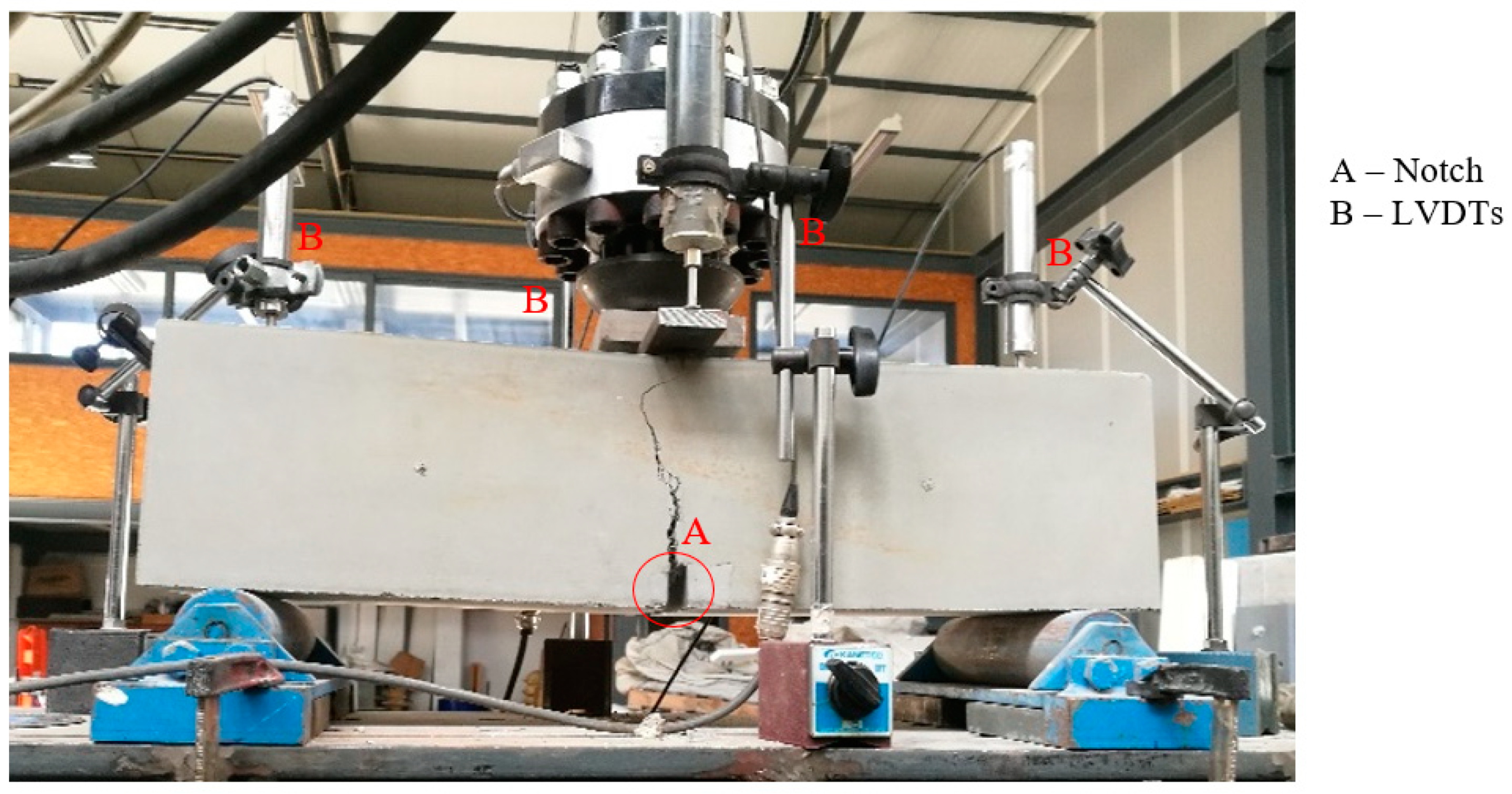

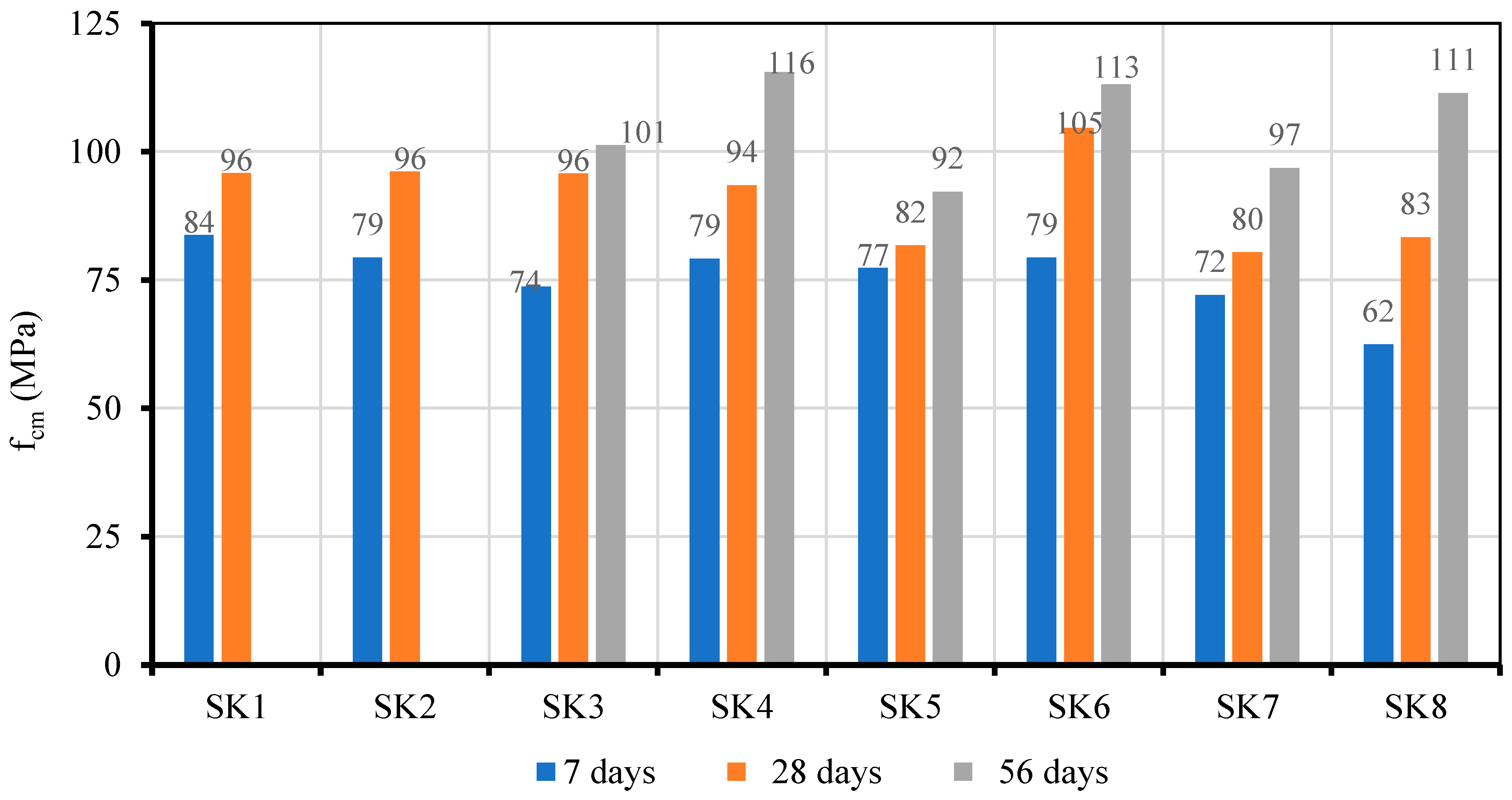

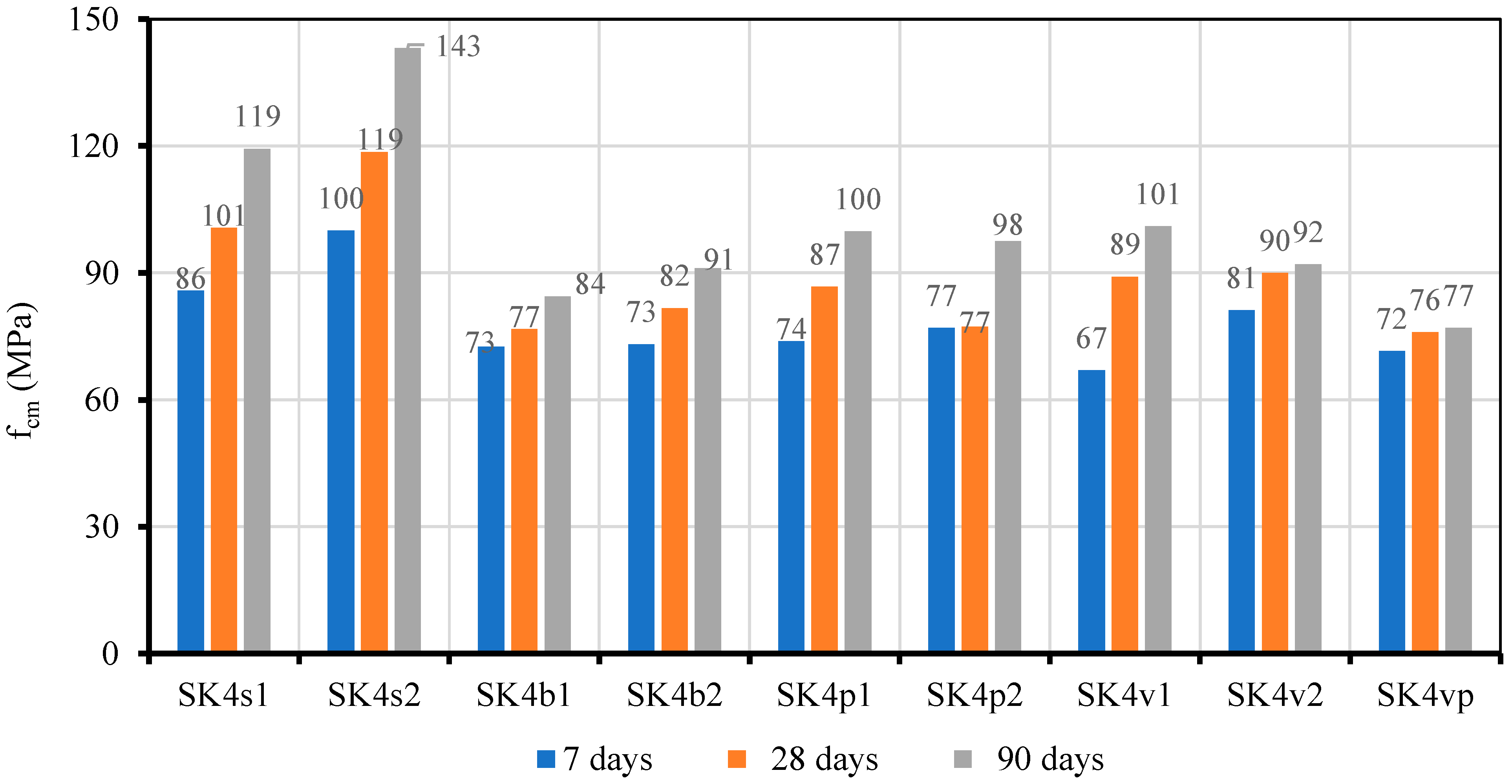
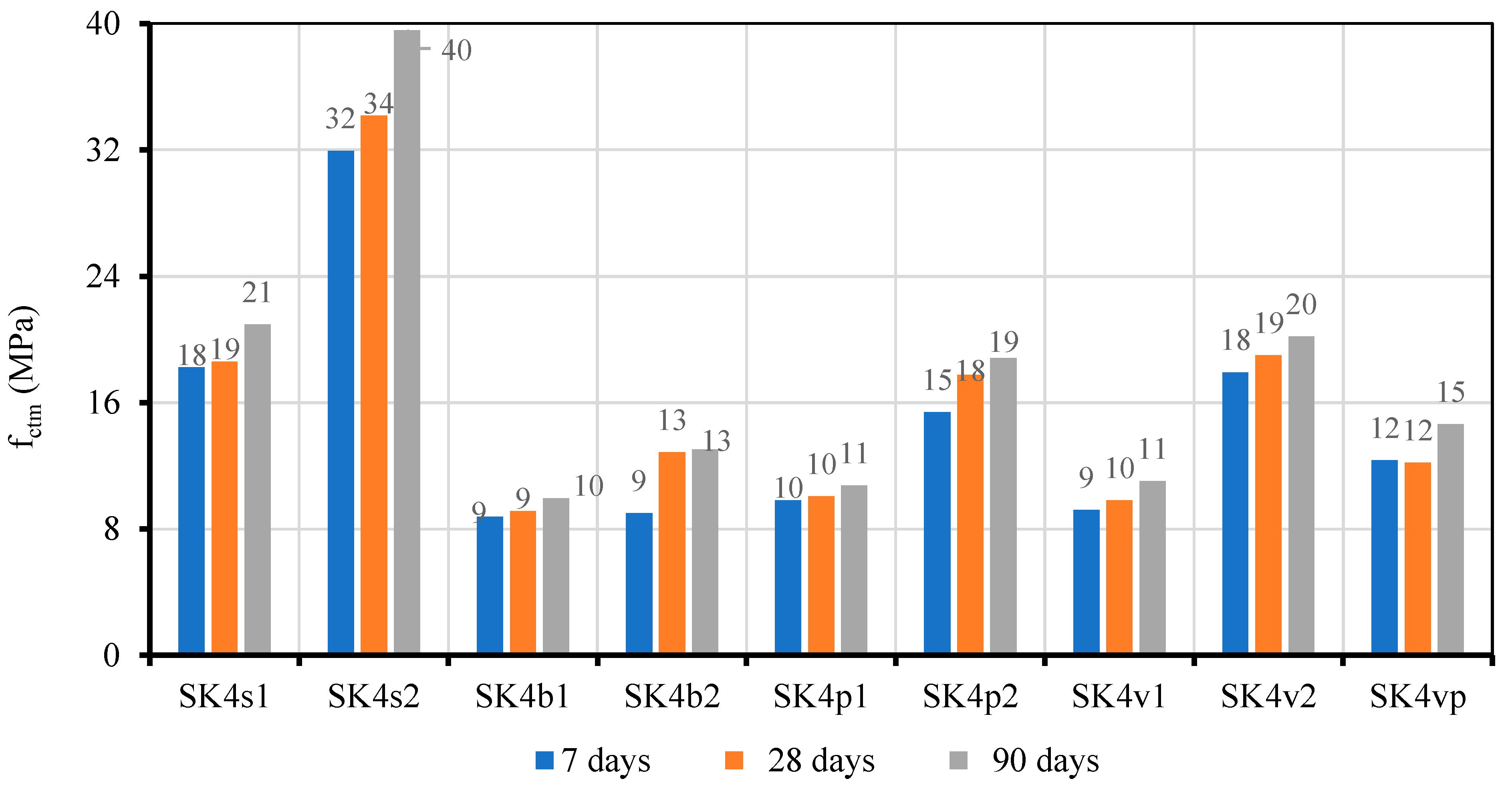
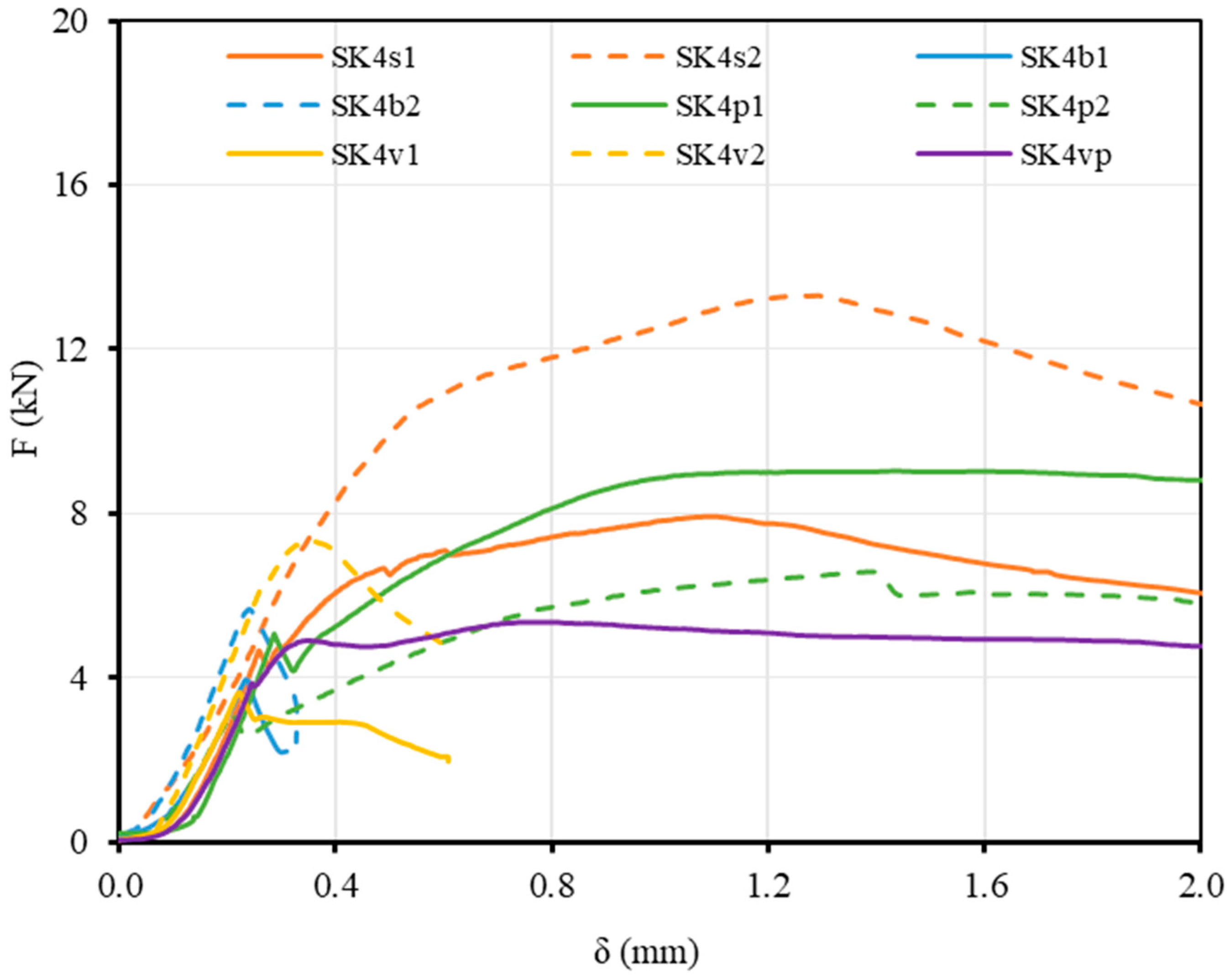
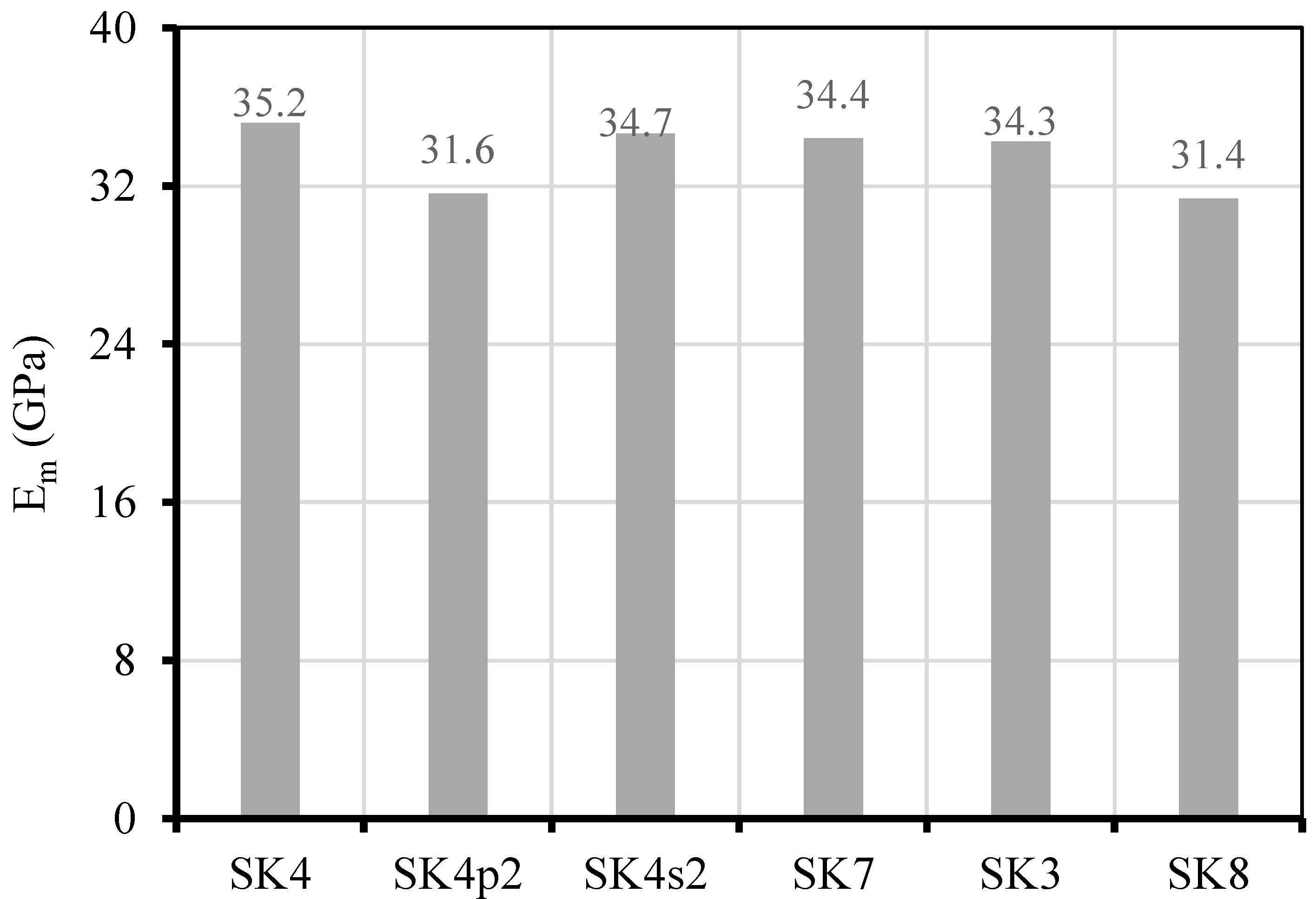

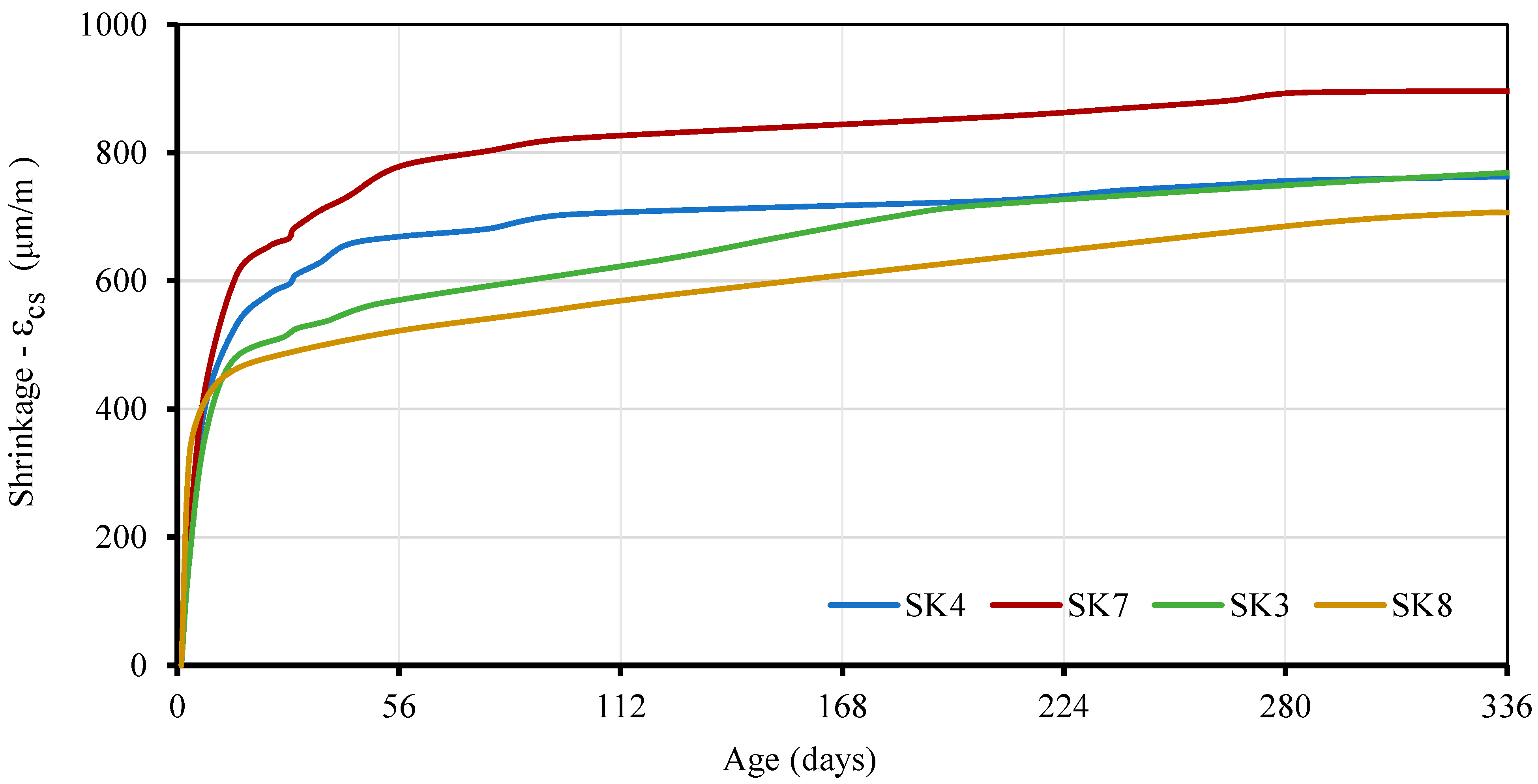
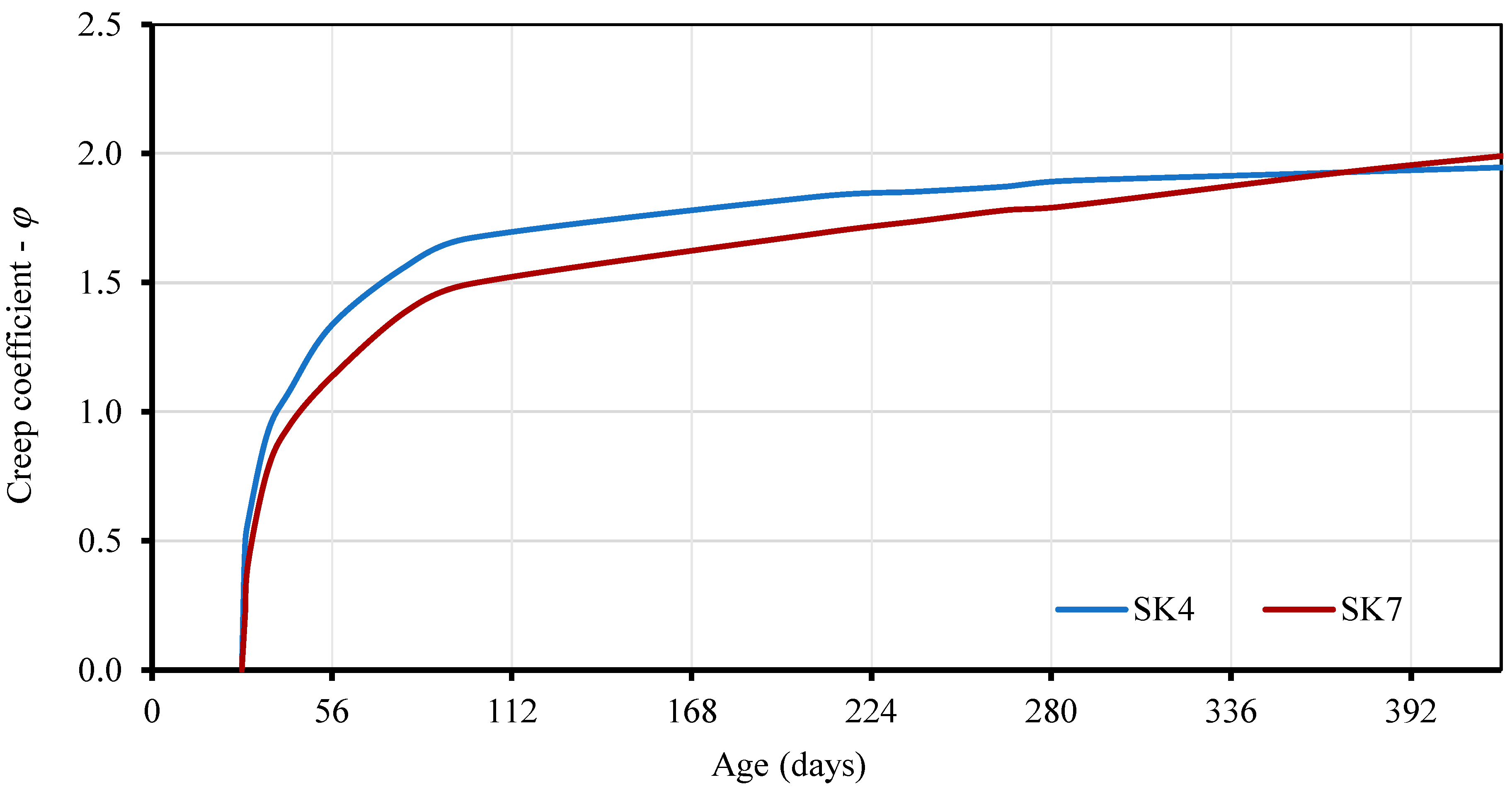
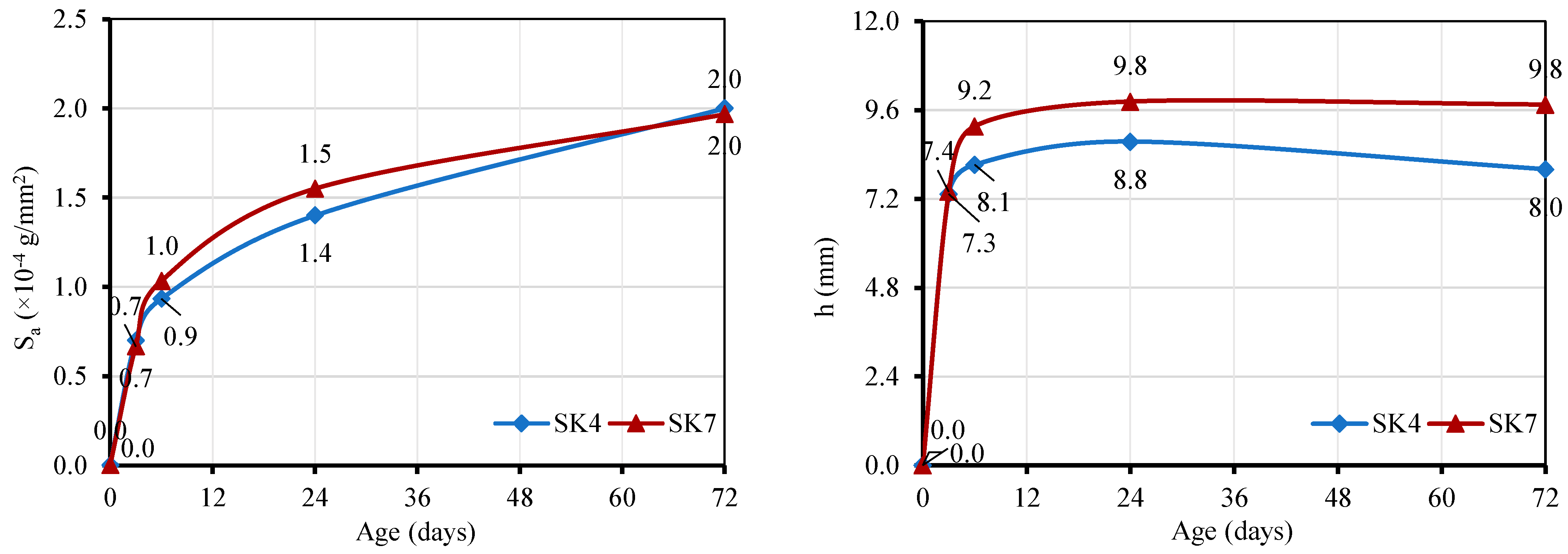
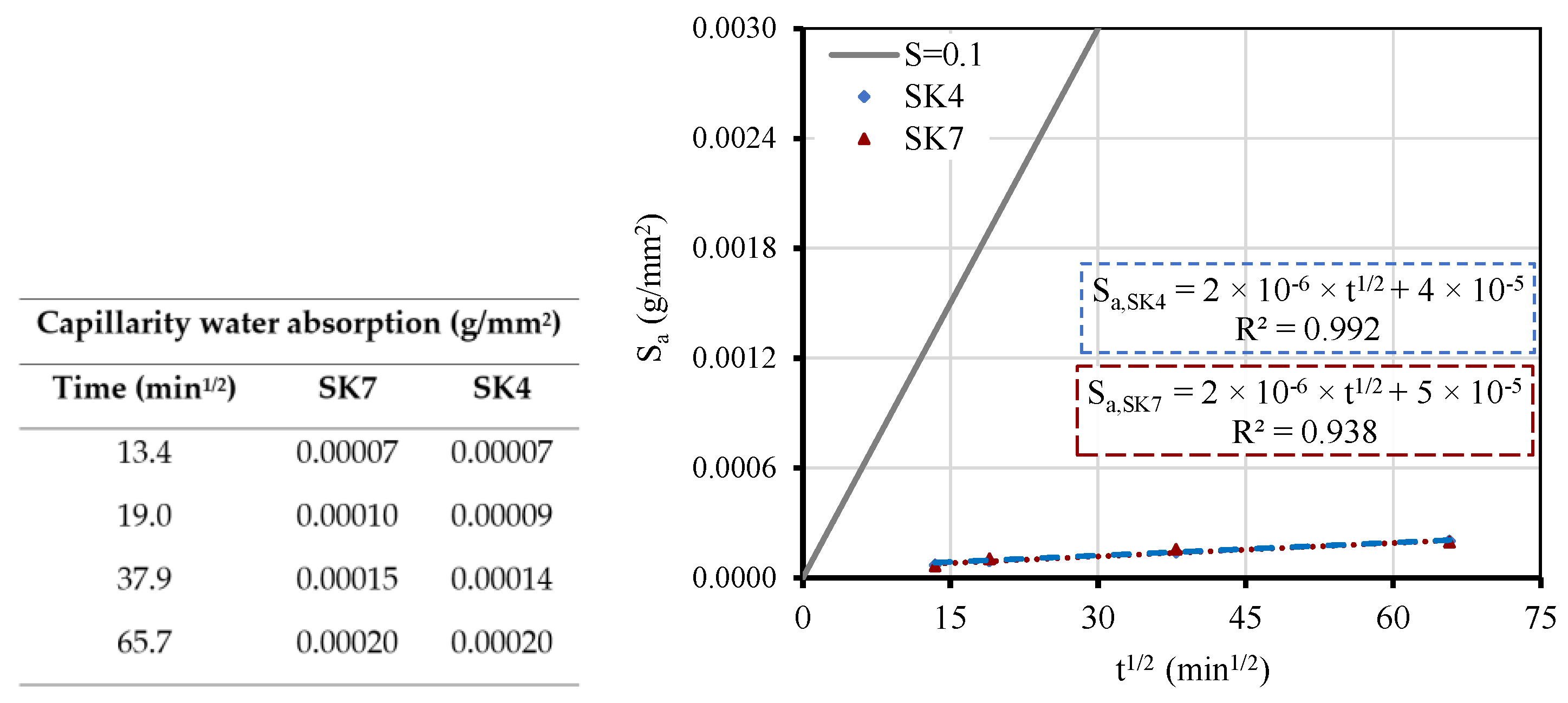
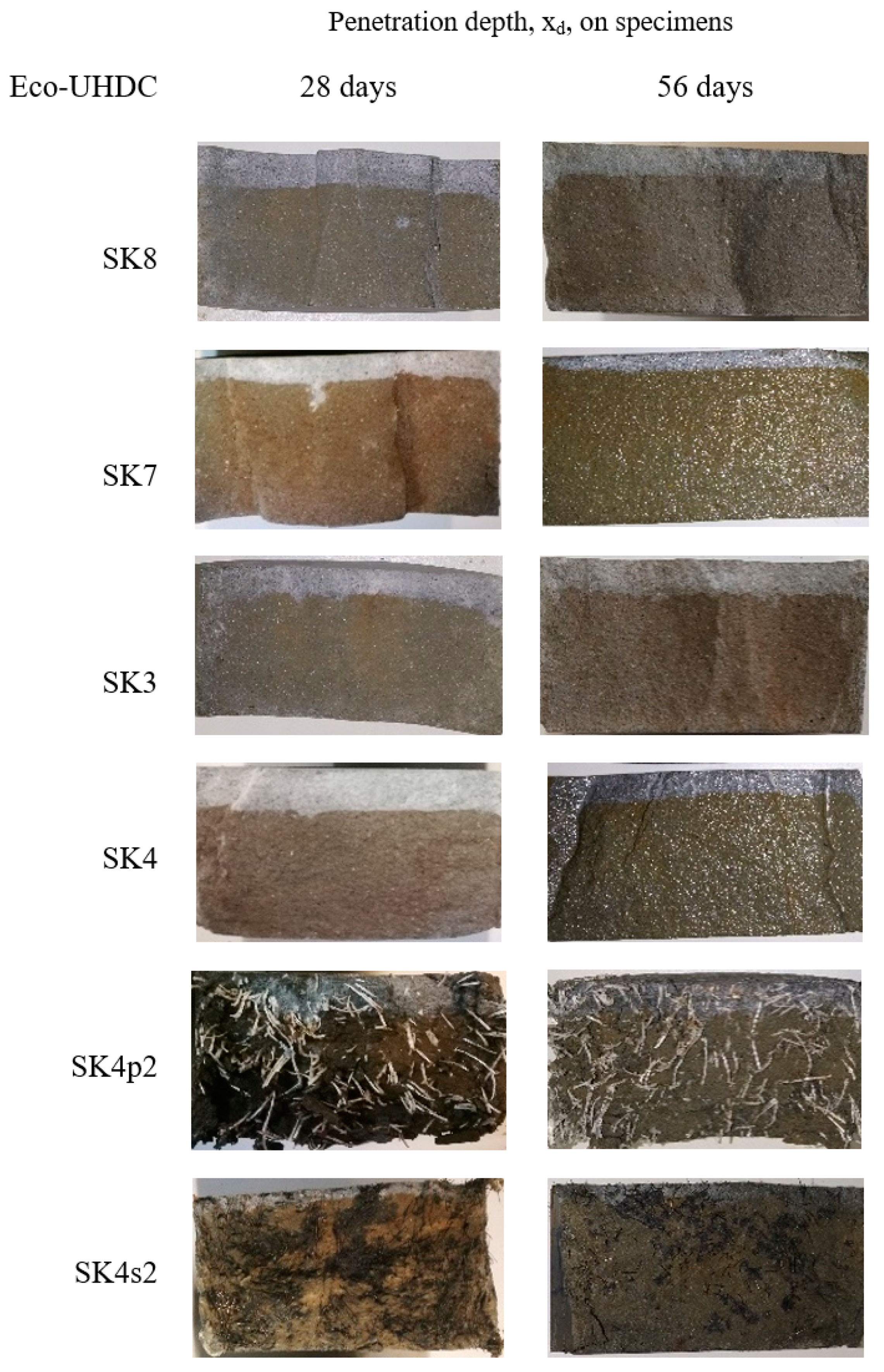
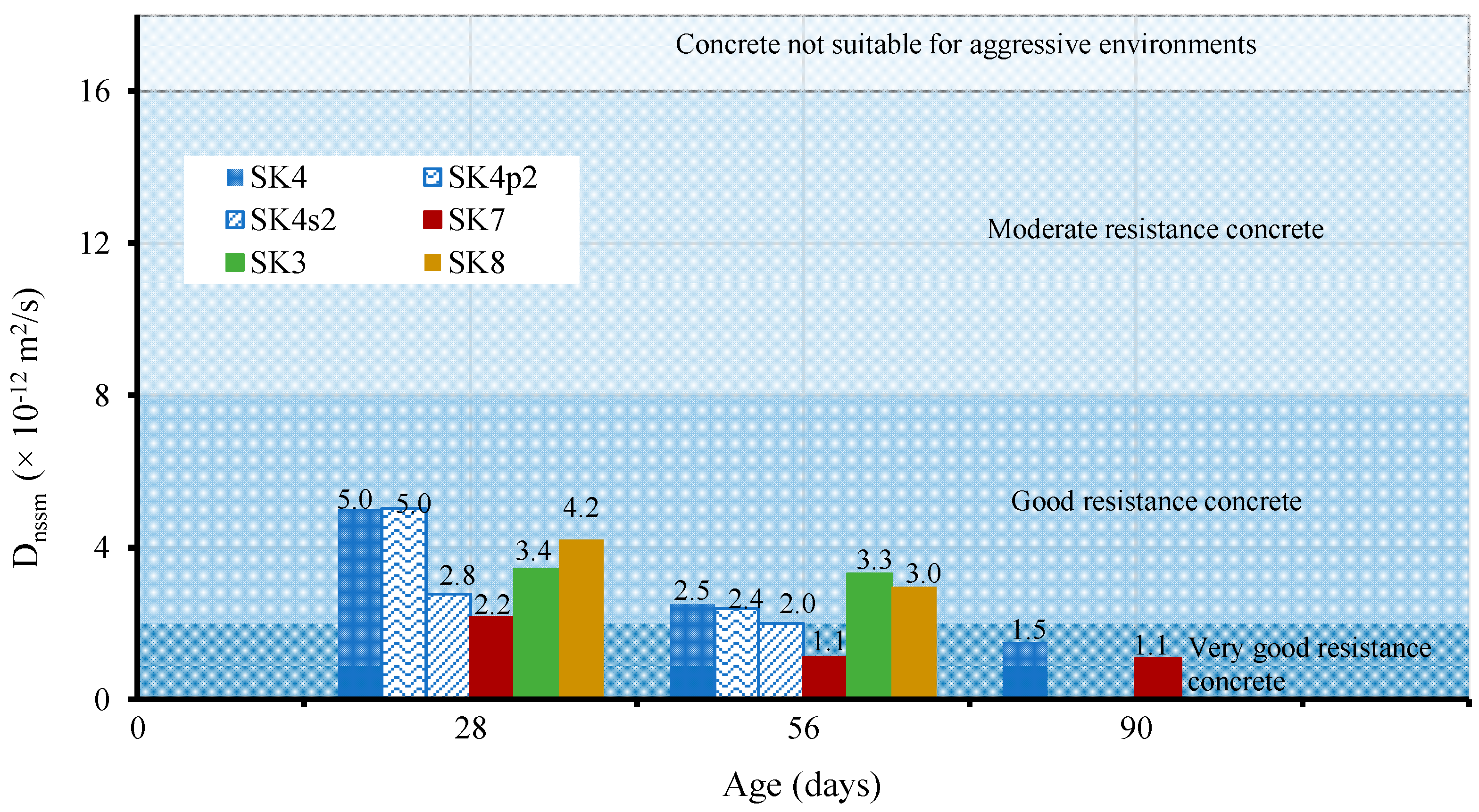
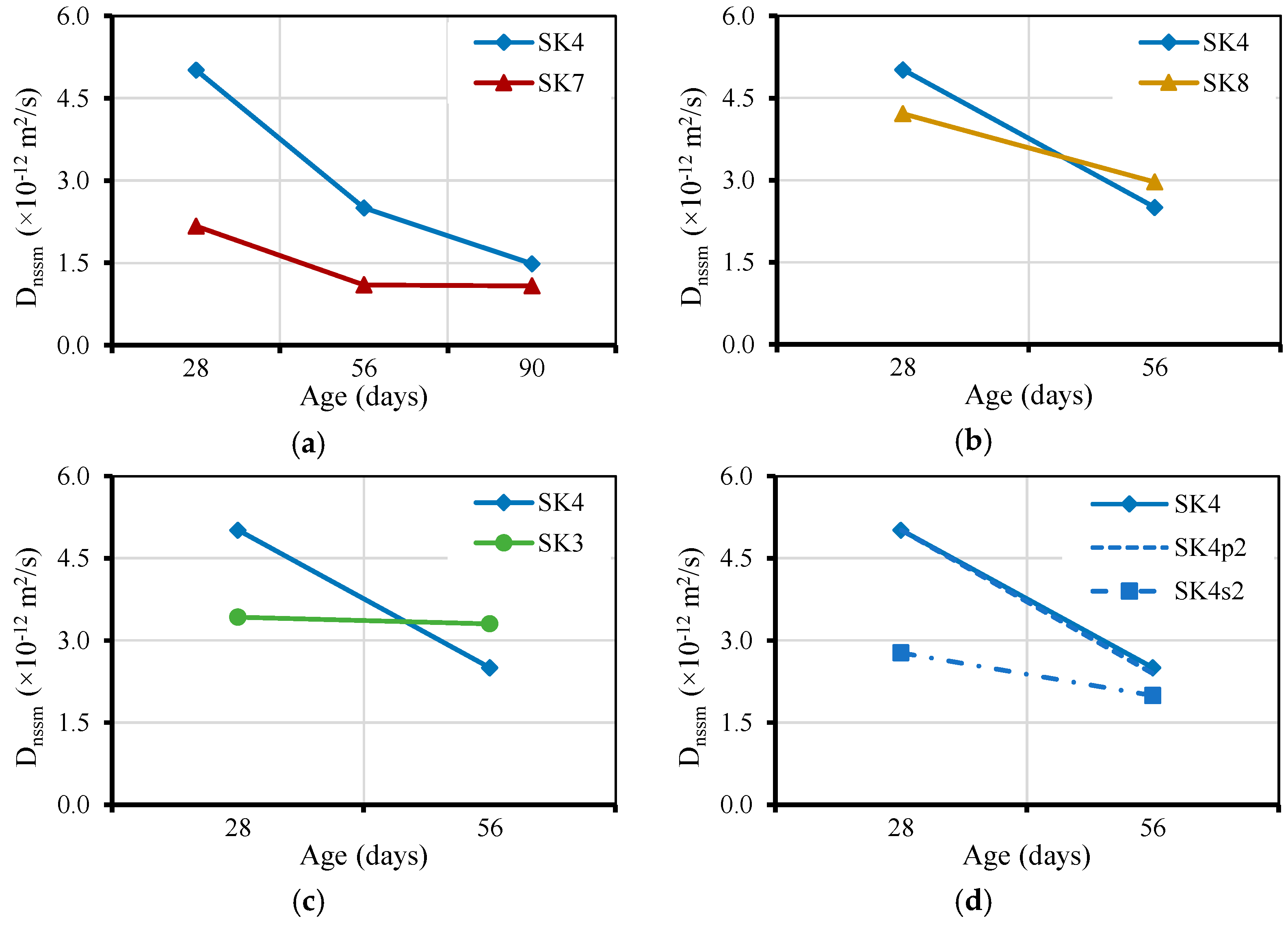
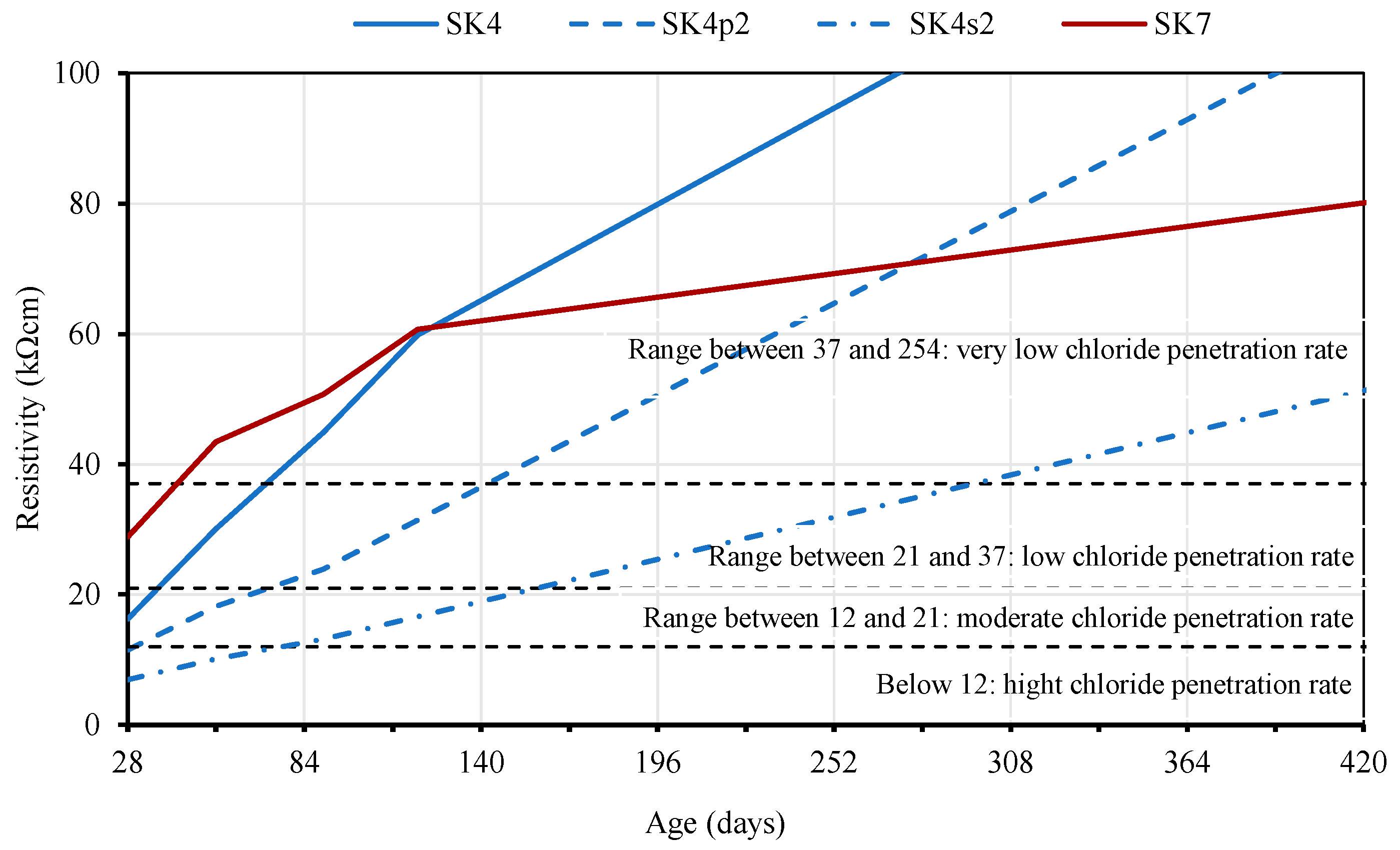
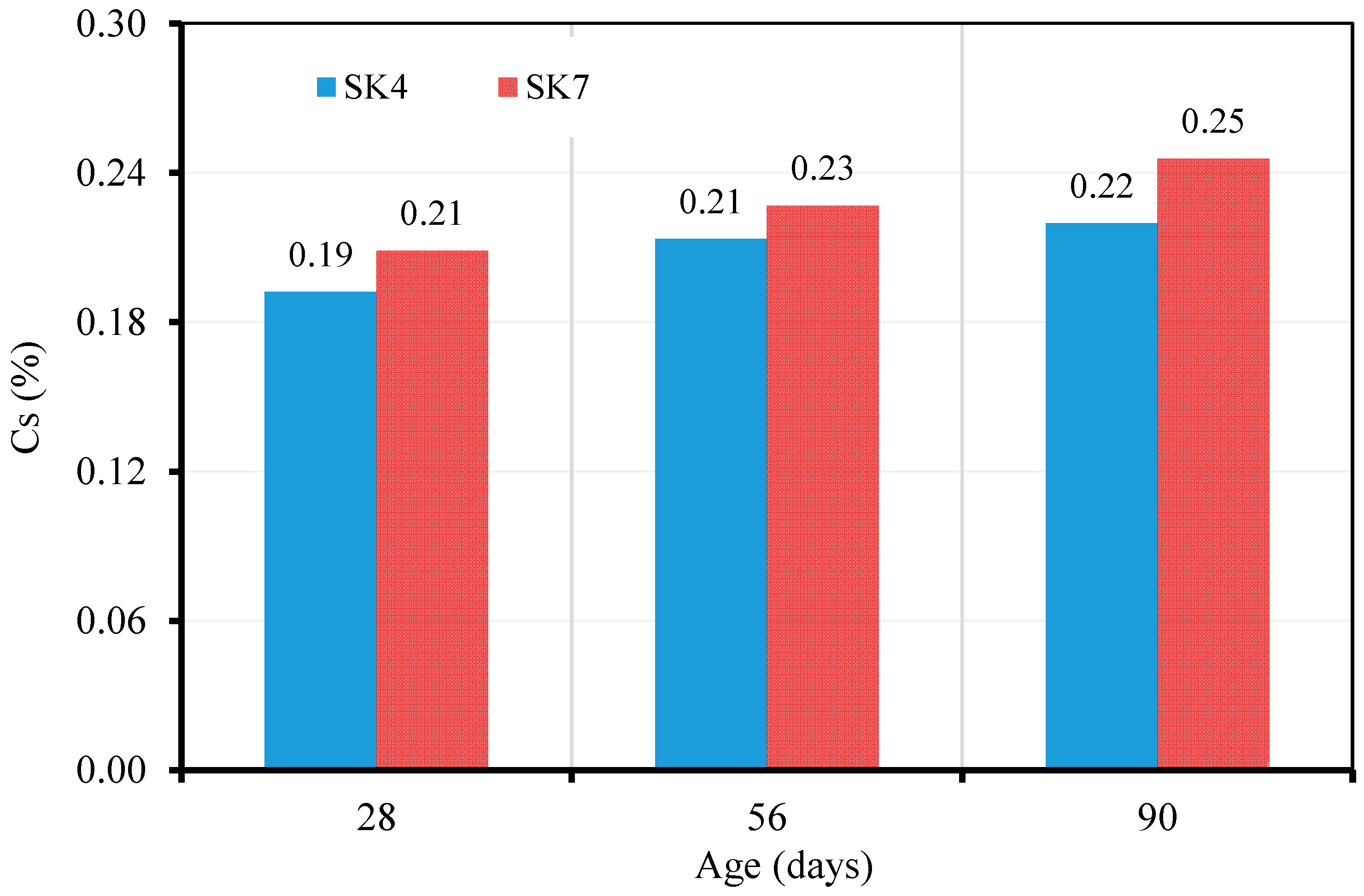
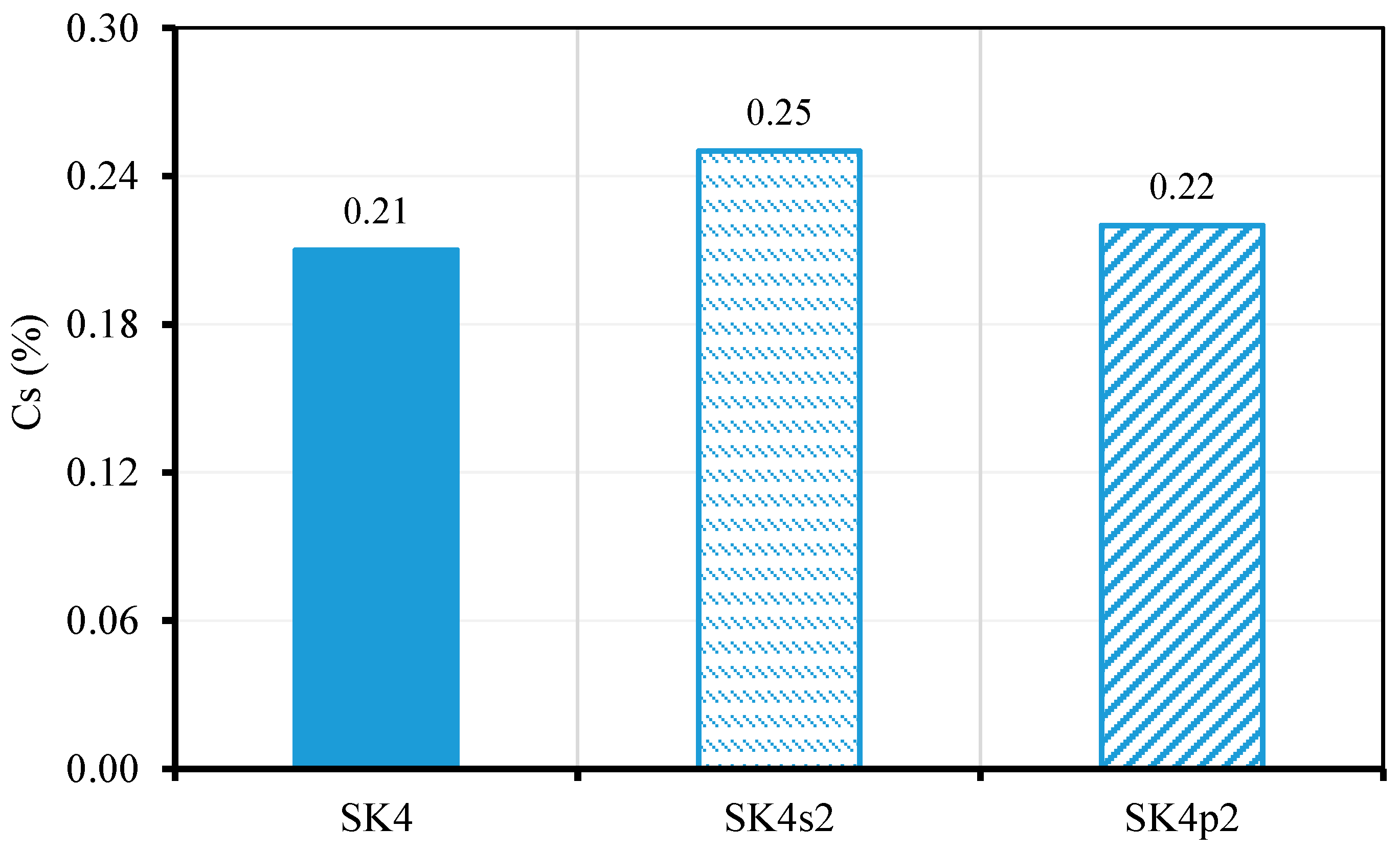

| Steel Fibers | Polymeric Fibers | Glass Fibers | Basalt Fibers | |
|---|---|---|---|---|
| Tensile strength | 3000 MPa | 650 MPa | 1700 MPa | 3500 MPa |
| Young’s modulus | 200 GPa | 5 GPa | 72 GPa | 95 GPa |
| Density | 7.85 g/cm3 | 0.92 g/cm3 | 2.68 g/cm3 | 2.67 g/cm3 |
| Diameter | 0.16 mm | 0.3 to 0.5 mm | 14 µm | 18 µm |
| Length | 13 mm | 25 mm | 12 mm | 13 mm |
| C = 75%; FA = 15%; Other Additions = 10% | C = 60%; LF = 25%; Other Additions = 15% | C = 60%; LF = 15%; FA =25% | |||||||
|---|---|---|---|---|---|---|---|---|---|
| Mixtures | SK1 | SK2 | SK3 | SK4 | SK5 | SK6 | SK7 | SK8 | |
| Binder powder dosage | kg/m3 | 1100 | |||||||
| Water/binder powder (W/B) | 0.195 | 0.18 | 0.21 | ||||||
| Cement (C) | (kg/m3) | 825 | 825 | 660 | 660 | 660 | 660 | 660 | 660 |
| Limestone filler (LF) | (kg/m3) | 110 | 275 | 275 | 275 | 275 | 275 | 165 | |
| Fly ash (FA) | (kg/m3) | 165 | 165 | 165 | 165 | 275 | |||
| Silica fume | (kg/m3) | 165 | |||||||
| Pozzolan—Cape Verde | (kg/m3) | 165 | |||||||
| Quartz flour | (kg/m3) | 110 | 165 | ||||||
| Water | (kg/m3) | 215 | 215 | 198 | 231 | 231 | 231 | 231 | 231 |
| Admixture (Spl) | (kg/m3) | 29 | 35 | 30 | 13 | 15 | 25 | 18 | 17 |
| Sand 0/1 mm | (kg/m3) | 983 | 969 | 1006 | 961 | 974 | 919 | 937 | 936 |
| Mixtures | C | LF | FA | Water | Spl | Sand 0/1 mm | Fibers | |
|---|---|---|---|---|---|---|---|---|
| (kg/m3) | Types and % by Volume | (kg/m3) | ||||||
| SK4s1 | 660 | 275 | 165 | 231 | 13 | 934 | Steel—1% | 79 |
| SK4s2 | 13 | 907 | Steel—2% | 157 | ||||
| SK4b1 | 18 | 920 | Basalt—1% | 27 | ||||
| SK4b2 | 21 | 888 | Basalt—2% | 53 | ||||
| SK4p1 | 13 | 907 | Polymeric—2% | 18 | ||||
| SK4p2 | 14 | 853 | Polymeric—4% | 37 | ||||
| SK4g1 | 18 | 920 | Glass—1% | 27 | ||||
| SK4g2 | 21 | 874 | Glass—2% | 53 | ||||
| SK4gp | 18 | 868 | Glass—1% + Polymeric—2% | 27 + 18 | ||||
| Air Content (%) | Slump Flow Spread (cm) | ||
|---|---|---|---|
| Eco-UHDC | SK1 | 1 | 34 |
| SK2 | 0.9 | 35 | |
| SK3 | 1.1 | 31 | |
| SK4 | 1.5 | 33 | |
| SK5 | 0.6 | 34 | |
| SK6 | 1.7 | 30 | |
| SK7 | 1.5 | 32 | |
| SK8 | 1.2 | 35 | |
| Eco- UHDFRC | SK4s1 | 1 | 33 |
| SK4s2 | 1.2 | 32 | |
| SK4b1 | 1.5 | 30 | |
| SK4b2 | 1.9 | 24 | |
| SK4p1 | 2.8 | 29 | |
| SK4p2 | 3.1 | 25 | |
| SK4g1 | 1.4 | 28 | |
| SK4g2 | 2 | 26 | |
| SK4gp | 1.5 | 27 | |
| Residual Flexural Tensile Strength (MPa) | ||||||
|---|---|---|---|---|---|---|
| Mixtures | fR1 | fR2 | fR3 | fR4 | fFts | fFtu |
| SK4s2 | 24 | 33 | 29 | 25 | 10.9 | 9.7 |
| SK4p2 | 11 | 12 | 12 | 11 | 5 | 4 |
| Mixtures | C7 Days (mm) | C28 Days (mm) | C56 Days (mm) | C90 Days (mm) |
|---|---|---|---|---|
| SK4 | 0 | 0 | 2 | 2 |
| SK7 | 0 | 0 | 2 | 2 |
| SK4s2 | 0 | 0 | 0 | 2 |
| SK4p2 | 0 | 0 | 0 | 0 |
| Eco-UHDC | SK4 | SK4s2 | SK4p2 |
|---|---|---|---|
| (mm) | |||
| Edge A | 8 | 10 | 8 |
| Edge B | 7 | 7 | 15 |
| Edge C | 5 | 7 | 7 |
| Edge D | 4 | 7 | 5 |
| Average | 6 | 8 | 9 |
| Current Structures (Class S4, RC2, 50 Years) | Special Structures (Class S5, RC3, 100 Years) | ||||||||
|---|---|---|---|---|---|---|---|---|---|
| Exposure Class | XC2 | XC3 | XC4 * | XC4 ** | XC2 | XC3 | XC4 * | XC4 ** | |
| Eco-UHDC | Cmin,dur (mm) EC 2 | 25 | 30 | 30 | 35 | ||||
| SK4 | tg (years) | >>400 | >>400 | >>400 | >>400 | >>400 | >>400 | >>400 | >>400 |
| SK7 | >>400 | >>400 | >>400 | >>400 | >>400 | >>400 | >>400 | >>400 | |
| SK4s2 | >>400 | >>400 | >>400 | >>400 | >>400 | >>400 | >>400 | >>400 | |
| SK4p2 | >>400 | >>400 | >>400 | >>400 | >>400 | >>400 | >>400 | >>400 | |
| Current Structures | Special Structures | ||||||||||
|---|---|---|---|---|---|---|---|---|---|---|---|
| (Class S4, RC2, 50 Years) | (Class S5, RC3, 100 Years) | ||||||||||
| Exposure Class | XC2 | XC3 | XC4 * | XC4 ** | XC2 | XC3 | XC4 * | XC4 ** | |||
| Minimum cover Cmin,dur (mm) | EC2 | 25 | 25 | 30 | 30 | 30 | 35 | ||||
| Eco-UHDC | SK4 | 1.3 | 1.9 | 2.6 | 2.9 | 1.7 | 3.0 | 4.0 | 4.2 | ||
| SK7 | 1.3 | 1.9 | 2.6 | 2.9 | 1.7 | 3.0 | 4.0 | 4.2 | |||
| SK4s2 | 1.2 | 1.7 | 2.4 | 2.6 | 1.6 | 2.7 | 3.6 | 3.8 | |||
| SK4p2 | 0.6 | 0.9 | 1.2 | 1.3 | 0.8 | 1.3 | 1.8 | 1.9 | |||
| Current Structures (Class S4, RC2, 50 Years) | Special Structures (Class S5, RC3, 100 Years) | |||||||||
|---|---|---|---|---|---|---|---|---|---|---|
| Exposure Class | XS1 | XS2 | XS3 | XS1 | XS2 | XS3 | ||||
| 1 m | 1.4–25 m | 1 m | 1.4–25 m | |||||||
| Eco- UHDC | SK3 | tg (years) | 573 | 115 | 91 | 41 | 852 | 174 | 145 | 54 |
| SK4 | 246 | 77 | 66 | 18 | 365 | 127 | 112 | 23 | ||
| SK7 | 1581 | 211 | 158 | 113 | 2357 | 296 | 229 | 148 | ||
| SK8 | 362 | 91 | 75 | 26 | 539 | 145 | 124 | 34 | ||
| SK4s2 | 915 | 150 | 115 | 65 | 1361 | 218 | 175 | 86 | ||
| SK4p2 | 246 | 77 | 66 | 17 | 365 | 127 | 112 | 23 | ||
| Current Structures (Class S4, RC2, 50 Years) | Special Structures (Class S5, RC3, 100 Years) | |||||||||
|---|---|---|---|---|---|---|---|---|---|---|
| Exposure Class 1 | XS1 2 | XS2 3 | XS3 4 | XS1 2 | XS2 3 | XS3 4 | ||||
| 1 m | 1.4–25 m | 1 m | 1.4–25 m | |||||||
| Minimum cover Cmin,dur (mm) | EC2 | 35 | 40 | 45 | 40 | 45 | 50 | |||
| Eco- UHDC | SK3 | 20 | 23 | 26 | 47 | 25 | 29 | 33 | 58 | |
| SK4 | 24 | 28 | 31 | 57 | 30 | 36 | 39 | 70 | ||
| SK7 | 16 | 18 | 20 | 37 | 20 | 23 | 26 | 46 | ||
| SK8 | 22 | 26 | 29 | 52 | 27 | 33 | 36 | 64 | ||
| SK4s2 | 18 | 21 | 23 | 42 | 22 | 26 | 29 | 52 | ||
| SK4p2 | 24 | 28 | 31 | 57 | 30 | 36 | 39 | 70 | ||
Disclaimer/Publisher’s Note: The statements, opinions and data contained in all publications are solely those of the individual author(s) and contributor(s) and not of MDPI and/or the editor(s). MDPI and/or the editor(s) disclaim responsibility for any injury to people or property resulting from any ideas, methods, instructions or products referred to in the content. |
© 2023 by the authors. Licensee MDPI, Basel, Switzerland. This article is an open access article distributed under the terms and conditions of the Creative Commons Attribution (CC BY) license (https://creativecommons.org/licenses/by/4.0/).
Share and Cite
Robalo, K.; Costa, H.; Carmo, R.; Júlio, E. Development and Characterization of Eco-Efficient Ultra-High Durability Concrete. Sustainability 2023, 15, 2381. https://doi.org/10.3390/su15032381
Robalo K, Costa H, Carmo R, Júlio E. Development and Characterization of Eco-Efficient Ultra-High Durability Concrete. Sustainability. 2023; 15(3):2381. https://doi.org/10.3390/su15032381
Chicago/Turabian StyleRobalo, Keila, Hugo Costa, Ricardo Carmo, and Eduardo Júlio. 2023. "Development and Characterization of Eco-Efficient Ultra-High Durability Concrete" Sustainability 15, no. 3: 2381. https://doi.org/10.3390/su15032381
APA StyleRobalo, K., Costa, H., Carmo, R., & Júlio, E. (2023). Development and Characterization of Eco-Efficient Ultra-High Durability Concrete. Sustainability, 15(3), 2381. https://doi.org/10.3390/su15032381









